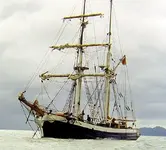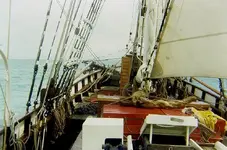Hi All, interesting subject regarding the clippers my main hobby for many years was ship modelling and other things along the same lines although mostly from an earlier period but latterly i have had an interest in early steamers,
the clippers traded by the shortest route and where they could get the cargo, but it wasn’t just the American skippers going round the horn against the wind, many European and British ships did as well taking migrants to California and the gold fields these were anywhere from about 200 tons to about 600 and a lot of guano shipped from Valparaiso to the uk all going the wrong way against the prevailing winds either getting there or returning along with the American ships,
although many were built before 1830, the hey day of the American clippers was from about 1830 to 1850 after that the lucrative trade with migrants to California and those heading for the gold fields from the east coast dropped off and most American clippers were sold to European owners,
the larger ships that followed were Barques 4 masted first built of iron and then steel 1,000 to 2,000 tons and up wards and could carry a lot more cargo and fitted with a brailing winch to turn the yards to the best position, these were on the deck in front or behind each mast also these were used to reef the sails as well to cut down on the crew,
i think this was a German invention and cut down the number of AB’s that were needed , like many things it was a progression, the largest was the Prussian a German ship 11,000 tons and five masted, she was sunk in the channel when she ran into a steamer that misjudged her speed and tried to cut across her bow the Prussian was doing 16 knots at the time,
the wages were poor a skipper in 1860 got about 100 US dollars a month the first mate and carpenter about 40 and the poor crewman about 20
eventually the steamers captured all the trade except on the longest routs especially after they invented the compound engine but as crow mentions right up to 1930 they could still make a profit shipping grain and wool from Oz to the UK as they didn't need coaling facilities,
the little ship in José's Photo was originally a Baltic trader, small ships used round the Baltic sea and to Norway for all sorts of cargo, many between the wars had their masts removed and fitted with a diesel engine, i have seen one photo, a small ship like joses photo, without masts taken in the 1950’s loaded with timber so high above the deck that it was higher than the deck to the waterline,
these were mostly family owned and well looked after, and as the Baltic is a dead sea has very little marine life to destroy the timber if looked after and treated, in the last 30 years a number have been saved and refitted by groups and single enthusiasts to what they were when they were built in the 1900’s
the one shown was probably German or Norwegian going off her hull design (that's a guess) , re masted and re rigged, with fore and aft sails on the mizzen and square on the fore and would be termed a brigantine, or hermaphrodite brig, and a beautiful little ship, although it could be a completely new build sometime in the last 10 years as I have a vague recollection that a Norwegian group have raised money for that,
John






 But she is virtually a new boat from the mid 1980,s She now sails under the name Drumbeat. kanacki has sailed her around the world 3 times. I have sailed on her twice before. Panama to Valparaiso to Marquess to Tahiti then to Auckland New Zealand. Another time Solomon Islands and New Guinea and New Britain to Melanesia. She looks almost identical to another vessel that has be scrapped just recently.
But she is virtually a new boat from the mid 1980,s She now sails under the name Drumbeat. kanacki has sailed her around the world 3 times. I have sailed on her twice before. Panama to Valparaiso to Marquess to Tahiti then to Auckland New Zealand. Another time Solomon Islands and New Guinea and New Britain to Melanesia. She looks almost identical to another vessel that has be scrapped just recently.

 I am effectively only 39 into my third childhood. Snifff
I am effectively only 39 into my third childhood. Snifff
